The Automatic Emergency Braking System Market is estimated to be valued at USD 73.1 billion in 2025 and is projected to reach USD 134.7 billion by 2035, registering a compound annual growth rate (CAGR) of 6.3% over the forecast period.
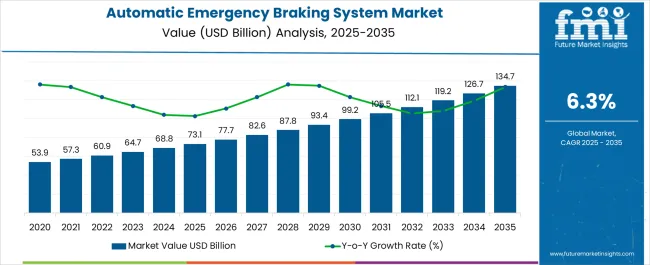
| Metric | Value |
|---|---|
| Automatic Emergency Braking System Market Estimated Value in (2025 E) | USD 73.1 billion |
| Automatic Emergency Braking System Market Forecast Value in (2035 F) | USD 134.7 billion |
| Forecast CAGR (2025 to 2035) | 6.3% |
The Automatic Emergency Braking (AEB) System market is witnessing strong expansion, driven by rising awareness of road safety and increasing regulatory mandates requiring advanced driver assistance systems in vehicles. AEB systems are designed to prevent or mitigate collisions by detecting obstacles ahead and automatically applying the brakes if the driver fails to respond.
The growing emphasis on reducing traffic fatalities and minimizing accident-related injuries has accelerated the adoption of these systems, especially in passenger cars and light commercial vehicles. Advancements in radar, lidar, and camera-based detection technologies are further enhancing the precision and reliability of AEB systems, making them more adaptable across varying road and traffic conditions.
Rising demand for semi-autonomous and autonomous driving features is also contributing to market growth as AEB remains a foundational component of advanced vehicle safety packages Increasing investments by automotive manufacturers in intelligent safety technologies and government-backed initiatives for safer mobility are expected to sustain long-term demand, ensuring the AEB market continues its upward trajectory globally.
The automatic emergency braking system market is segmented by product type, application type, vehicle type, and geographic regions. By product type, automatic emergency braking system market is divided into High Speed AEB System, Low Speed AEB System, and Pedestrians AEB System. In terms of application type, automatic emergency braking system market is classified into Crash Imminent Braking (CIB) and Dynamic Brake Support (DBS). Based on vehicle type, automatic emergency braking system market is segmented into Passenger Cars, Light Commercial Vehicle, and Heavy Commercial Vehicle. Regionally, the automatic emergency braking system industry is classified into North America, Latin America, Western Europe, Eastern Europe, Balkan & Baltic Countries, Russia & Belarus, Central Asia, East Asia, South Asia & Pacific, and the Middle East & Africa.
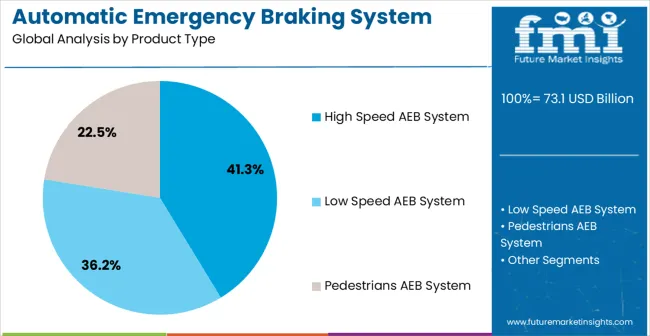
The high speed AEB system segment is projected to account for 41.3% of the market revenue in 2025, making it the leading product type. Growth is being driven by rising demand for safety systems capable of functioning effectively at highway speeds, where collision risks are higher and outcomes more severe. These systems leverage advanced radar and vision-based technologies to detect obstacles at greater distances, allowing vehicles to react quickly and prevent high-speed crashes.
The integration of high speed AEB systems into premium and mid-range vehicles is expanding, supported by consumer preference for enhanced safety features. Regulatory mandates in regions such as Europe and North America requiring high speed crash avoidance systems in new vehicles further strengthen market adoption.
The ability of high speed AEB to significantly reduce accident severity and save lives is positioning it as a critical feature in modern automotive design As infrastructure for connected and intelligent transport systems evolves, the demand for high speed AEB systems is expected to maintain its strong momentum.
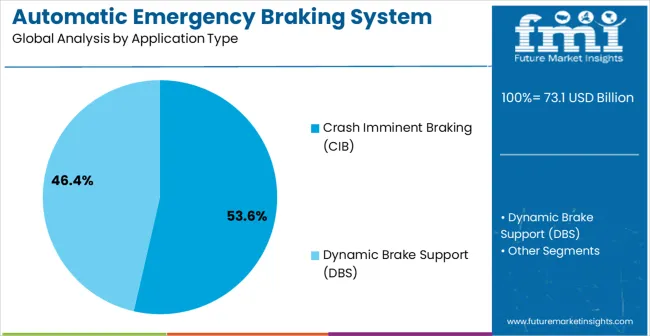
The crash imminent braking application segment is anticipated to hold 53.6% of the market revenue in 2025, making it the leading application type. Growth in this segment is being driven by the increasing need for proactive safety technologies that can intervene during critical driving scenarios where collisions are imminent. Crash imminent braking systems rely on advanced sensor fusion, combining radar, lidar, and vision inputs to detect potential threats and apply braking autonomously if driver reaction is delayed.
These systems have proven highly effective in reducing rear-end collisions, which remain among the most common types of accidents. Governments and safety authorities are encouraging wider implementation of crash imminent braking as part of mandatory vehicle safety standards, boosting adoption across both passenger and commercial vehicles.
The growing inclusion of this technology in mass-market models is enhancing consumer accessibility and confidence As automakers continue to enhance system responsiveness and integrate with autonomous driving technologies, crash imminent braking is expected to remain a core driver of the AEB market.
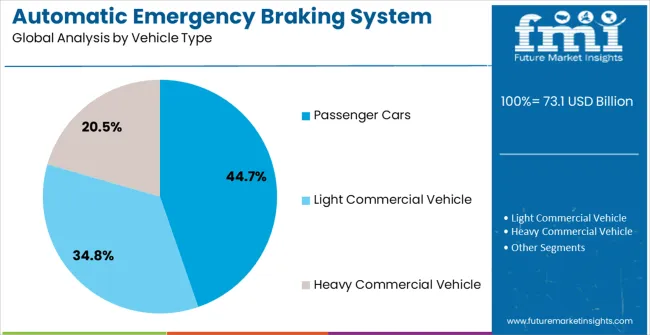
The passenger cars segment is expected to account for 44.7% of the market revenue in 2025, making it the leading vehicle type. Rising consumer awareness of safety technologies and regulatory mandates for equipping new passenger cars with AEB systems are major drivers of this segment’s dominance. Automakers are increasingly integrating AEB as a standard feature in compact, mid-range, and luxury vehicles, enhancing both safety and brand competitiveness.
Passenger cars, due to their high production volumes and widespread global usage, represent the largest platform for implementing AEB systems. The segment is also benefiting from growing demand for electric and semi-autonomous vehicles, where AEB forms part of broader advanced driver assistance system packages.
Enhanced affordability of safety technologies and ongoing improvements in detection accuracy across various driving conditions are further boosting adoption As urbanization and vehicle ownership increase in emerging economies, coupled with stricter safety standards in developed markets, passenger cars are expected to remain the largest contributor to the AEB system market’s growth.
An automotive must fulfill its basic functionality of transporting man and material from one place to another. But in today’s era, besides adhering to basic functionality automotive have the responsibility of ensuring safety of the occupant at the time of an emergency, where human response is unable to avoid the crash.
This has caused a significant revolution in the automotive safety system market through the introduction of advanced technologies, such as ADAS (advanced driver assist systems). The automatic emergency braking system utilizes electronic stability control (ESC) and ADAS to slow the vehicle and potentially reduce the severity of an impact when a crash is unavoidable.
Thus, the automatic emergency braking system acts as a helpful feature in high speed situations. The automatic emergency braking system is usually coupled with a forward collision warning system. The former incorporates camera based or radar based sensors that detect the distance of the vehicle from the one ahead.
Warning signals are provided in the possibility of a crash, so that the driver can take corrective action, if no action is received from the driver, brakes are applied automatically to decelerate the vehicle. The automatic emergency braking system doesn’t claim to completely mitigate the collision, but reduces the intensity of collision.
Presently, when mapped on the product life cycle stage, the automatic emergency braking system market is still between the introduction and growth phase; thus, noteworthy growth is expected in the market over the forecast period.
Commercially, the automatic driver system is also known as the pre-crash braking system, intelligent braking system and forward collision mitigation system. Various national and international regulating organizations support the automatic emergency braking system as they find it a potential means of reducing severe rear-end collisions and thus helpful in saving lives.
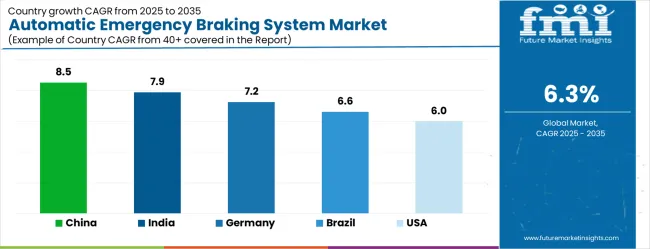
| Country | CAGR |
|---|---|
| China | 8.5% |
| India | 7.9% |
| Germany | 7.2% |
| Brazil | 6.6% |
| USA | 6.0% |
| UK | 5.4% |
| Japan | 4.7% |
The Automatic Emergency Braking System Market is expected to register a CAGR of 6.3% during the forecast period, exhibiting varied country level momentum. China leads with the highest CAGR of 8.5%, followed by India at 7.9%. Developed markets such as Germany, France, and the UK continue to expand steadily, while the USA is likely to grow at consistent rates. Japan posts the lowest CAGR at 4.7%, yet still underscores a broadly positive trajectory for the global Automatic Emergency Braking System Market. In 2024, Germany held a dominant revenue in the Western Europe market and is expected to grow with a CAGR of 7.2%. The USA Automatic Emergency Braking System Market is estimated to be valued at USD 27.7 billion in 2025 and is anticipated to reach a valuation of USD 27.7 billion by 2035. Sales are projected to rise at a CAGR of 0.0% over the forecast period between 2025 and 2035. While Japan and South Korea markets are estimated to be valued at USD 4.0 billion and USD 1.9 billion respectively in 2025.
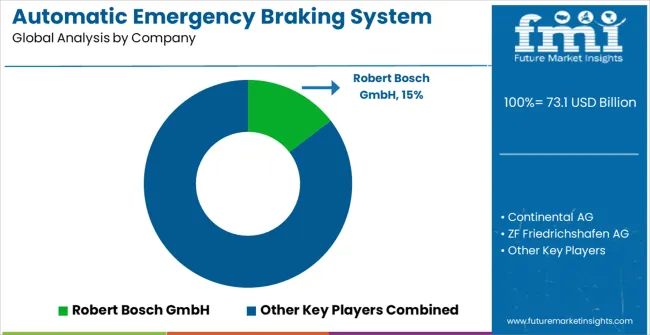
| Item | Value |
|---|---|
| Quantitative Units | USD 73.1 Billion |
| Product Type | High Speed AEB System, Low Speed AEB System, and Pedestrians AEB System |
| Application Type | Crash Imminent Braking (CIB) and Dynamic Brake Support (DBS) |
| Vehicle Type | Passenger Cars, Light Commercial Vehicle, and Heavy Commercial Vehicle |
| Regions Covered | North America, Europe, Asia-Pacific, Latin America, Middle East & Africa |
| Country Covered | United States, Canada, Germany, France, United Kingdom, China, Japan, India, Brazil, South Africa |
| Key Companies Profiled | Robert Bosch GmbH, Continental AG, ZF Friedrichshafen AG, DENSO Corporation, Hyundai Mobis Co., Ltd., Aptiv PLC, Autoliv Inc., Valeo SA, Magna International Inc., Mobileye Global Inc., Veoneer AB, Hitachi Astemo Ltd., and Mando Corporation |
The global automatic emergency braking system market is estimated to be valued at USD 73.1 billion in 2025.
The market size for the automatic emergency braking system market is projected to reach USD 134.7 billion by 2035.
The automatic emergency braking system market is expected to grow at a 6.3% CAGR between 2025 and 2035.
The key product types in automatic emergency braking system market are high speed aeb system, low speed aeb system and pedestrians aeb system.
In terms of application type, crash imminent braking (cib) segment to command 53.6% share in the automatic emergency braking system market in 2025.






Our Research Products

The "Full Research Suite" delivers actionable market intel, deep dives on markets or technologies, so clients act faster, cut risk, and unlock growth.

The Leaderboard benchmarks and ranks top vendors, classifying them as Established Leaders, Leading Challengers, or Disruptors & Challengers.

Locates where complements amplify value and substitutes erode it, forecasting net impact by horizon

We deliver granular, decision-grade intel: market sizing, 5-year forecasts, pricing, adoption, usage, revenue, and operational KPIs—plus competitor tracking, regulation, and value chains—across 60 countries broadly.

Spot the shifts before they hit your P&L. We track inflection points, adoption curves, pricing moves, and ecosystem plays to show where demand is heading, why it is changing, and what to do next across high-growth markets and disruptive tech

Real-time reads of user behavior. We track shifting priorities, perceptions of today’s and next-gen services, and provider experience, then pace how fast tech moves from trial to adoption, blending buyer, consumer, and channel inputs with social signals (#WhySwitch, #UX).

Partner with our analyst team to build a custom report designed around your business priorities. From analysing market trends to assessing competitors or crafting bespoke datasets, we tailor insights to your needs.
Supplier Intelligence
Discovery & Profiling
Capacity & Footprint
Performance & Risk
Compliance & Governance
Commercial Readiness
Who Supplies Whom
Scorecards & Shortlists
Playbooks & Docs
Category Intelligence
Definition & Scope
Demand & Use Cases
Cost Drivers
Market Structure
Supply Chain Map
Trade & Policy
Operating Norms
Deliverables
Buyer Intelligence
Account Basics
Spend & Scope
Procurement Model
Vendor Requirements
Terms & Policies
Entry Strategy
Pain Points & Triggers
Outputs
Pricing Analysis
Benchmarks
Trends
Should-Cost
Indexation
Landed Cost
Commercial Terms
Deliverables
Brand Analysis
Positioning & Value Prop
Share & Presence
Customer Evidence
Go-to-Market
Digital & Reputation
Compliance & Trust
KPIs & Gaps
Outputs
Full Research Suite comprises of:
Market outlook & trends analysis
Interviews & case studies
Strategic recommendations
Vendor profiles & capabilities analysis
5-year forecasts
8 regions and 60+ country-level data splits
Market segment data splits
12 months of continuous data updates
DELIVERED AS:
PDF EXCEL ONLINE
Automatic Chicken Deboning Machine Market Size and Share Forecast Outlook 2025 to 2035
Automatic Filter Press Solutions Market Size and Share Forecast Outlook 2025 to 2035
Automatic Filter Presses (AFPs) Market Size and Share Forecast Outlook 2025 to 2035
Automatic Riveting Equipment Market Forecast and Outlook 2025 to 2035
Automatic Powder Forming Machine Market Forecast and Outlook 2025 to 2035
Automatic Weigh Price Labeling Machine Market Size and Share Forecast Outlook 2025 to 2035
Automatic Bending Machine Market Size and Share Forecast Outlook 2025 to 2035
Automatic Transmission Market Size and Share Forecast Outlook 2025 to 2035
Automatic Impact Testing Machine Market Size and Share Forecast Outlook 2025 to 2035
Automatic Glue Machine Market Size and Share Forecast Outlook 2025 to 2035
Automatic Floodgate Market Size and Share Forecast Outlook 2025 to 2035
Automatic Die Cutting Machines Market Size and Share Forecast Outlook 2025 to 2035
Automatic Silver Sintering Die Attach Machine Market Size and Share Forecast Outlook 2025 to 2035
Automatic Identification and Data Capture Market Size and Share Forecast Outlook 2025 to 2035
Automatic Transfer Switch Market Size and Share Forecast Outlook 2025 to 2035
Automatic Weapons Market Size and Share Forecast Outlook 2025 to 2035
Automatic Bottle Opener Market Size and Share Forecast Outlook 2025 to 2035
Automatic Hog Feeder Market Size and Share Forecast Outlook 2025 to 2035
Automatic Goat Waterer Market Size and Share Forecast Outlook 2025 to 2035
Automatic Wine Dispensers Market Size and Share Forecast Outlook 2025 to 2035

Thank you!
You will receive an email from our Business Development Manager. Please be sure to check your SPAM/JUNK folder too.
Chat With
MaRIA